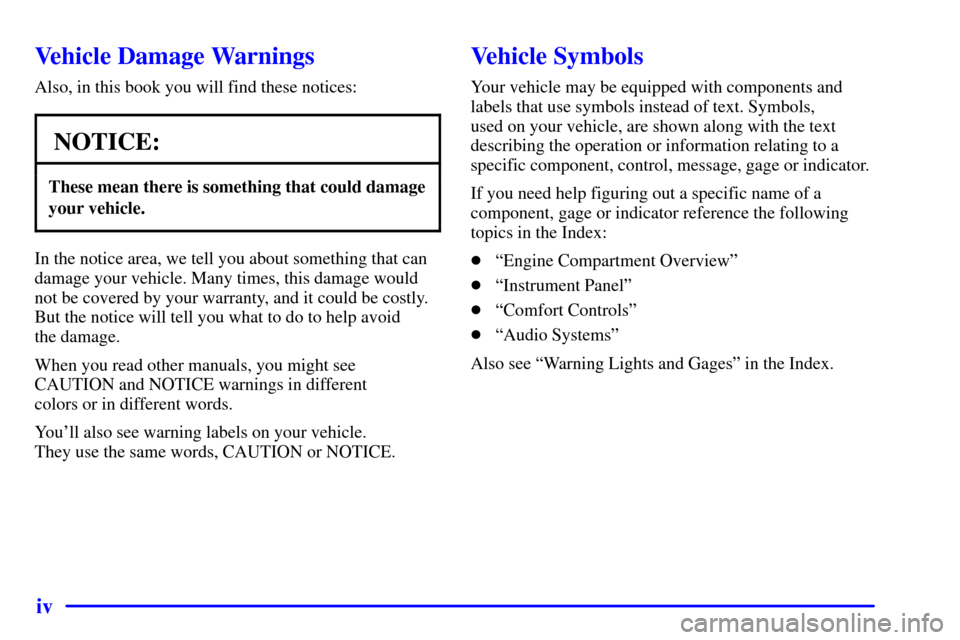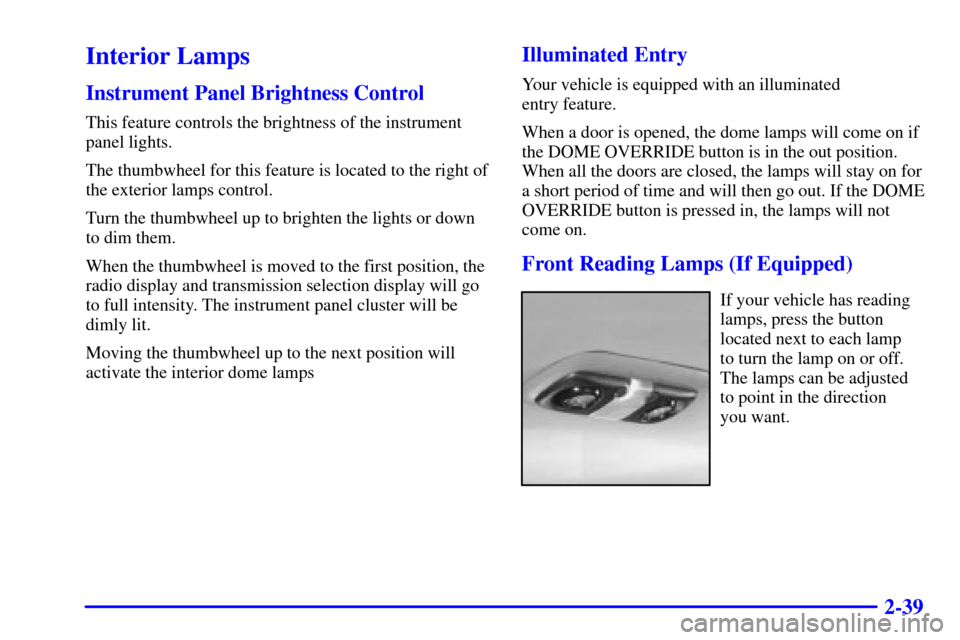Page 5 of 331

iv
Vehicle Damage Warnings
Also, in this book you will find these notices:
NOTICE:
These mean there is something that could damage
your vehicle.
In the notice area, we tell you about something that can
damage your vehicle. Many times, this damage would
not be covered by your warranty, and it could be costly.
But the notice will tell you what to do to help avoid
the damage.
When you read other manuals, you might see
CAUTION and NOTICE warnings in different
colors or in different words.
You'll also see warning labels on your vehicle.
They use the same words, CAUTION or NOTICE.
Vehicle Symbols
Your vehicle may be equipped with components and
labels that use symbols instead of text. Symbols,
used on your vehicle, are shown along with the text
describing the operation or information relating to a
specific component, control, message, gage or indicator.
If you need help figuring out a specific name of a
component, gage or indicator reference the following
topics in the Index:
�ªEngine Compartment Overviewº
�ªInstrument Panelº
�ªComfort Controlsº
�ªAudio Systemsº
Also see ªWarning Lights and Gagesº in the Index.
Page 16 of 331
1-9
The person keeps going until stopped by something.
In a real vehicle, it could be the windshield ...or the instrument panel ...
Page 44 of 331

2-
2-1
Section 2 Features and Controls
Here you can learn about the many standard and optional features on your vehicle, and information on starting,
shifting and braking. Also explained are the instrument panel and the warning systems that tell you if everything is
working properly
-- and what to do if you have a problem.
2
-2 Windows
2
-4 Keys
2
-6 Door Locks
2
-7 Keyless Entry System (If Equipped)
2
-10 Theft
2
-11 Passlock�
2-12 New Vehicle ªBreak-Inº
2
-12 Ignition Positions
2
-14 Starting Your Gasoline Engine
2
-16 Engine Coolant Heater (If Equipped)
2
-17 Automatic Transmission Operation
2
-21 Manual Transmission Operation
2
-23 Parking Brake
2
-24 Shifting Into PARK (P)
(Automatic Transmission Only)
2
-27 Shifting Out of PARK (P)
(Automatic Transmission Only)2
-27 Parking Your Vehicle
(Manual Transmission Models Only)
2
-28 Parking Over Things That Burn
2
-28 Engine Exhaust
2
-29 Running Your Engine While You're Parked
(Automatic Transmission)
2
-30 Tilt Wheel (If Equipped)
2
-30 Turn Signal/Multifunction Lever
2
-37 Exterior Lamps
2
-39 Interior Lamps
2
-41 Mirrors
2
-44 Storage Compartments
2
-48 Instrument Panel - Your Information System
2
-50 Instrument Panel Cluster
2
-52 Warning Lights, Gages and Indicators
Page 60 of 331

2-17
How long should you keep the coolant heater plugged
in? The answer depends on the outside temperature, the
kind of oil you have, and some other things. Instead of
trying to list everything here, we ask that you contact
your dealer in the area where you'll be parking your
vehicle. The dealer can give you the best advice for that
particular area.Automatic Transmission Operation
There are several different positions for your shift lever.
If your vehicle is equipped with an automatic
transmission, it features an electronic shift position
indicator within the instrument panel cluster. This
display must be powered any time the shift lever is
capable of being moved out of PARK (P). This means
that if your key is in OFF, rather than LOCK, there will
be a small current drain on your battery which could
discharge your battery over a period of time. If you have
to leave your key in the ignition in OFF for an extended
period, it is recommended that you disconnect the
battery cable from the battery to prevent discharging
your battery.
Page 74 of 331

2-31 Turn and Lane Change Signals
The turn signal has two upward (for right) and two
downward (for left) positions. These positions allow you
to signal a turn or a lane change.
To signal a turn, move the lever all the way up or down.
When the turn is finished, the lever will return
automatically.
An arrow located on the
instrument panel cluster will
flash in the direction of the
turn or lane change.
To signal a lane change, just raise or lower the lever
until the arrow starts to flash. Hold it there until you
complete your lane change. The lever will return by
itself when you release it.If you move the lever all the way up or down, and the
arrow flashes at twice the normal rate, a signal bulb
may be burned out and other drivers may not see your
turn signal.
If a bulb is burned out, replace it to help avoid an
accident. If the arrows don't go on at all when you
signal a turn, check for burned
-out bulbs and a blown
fuse. See ªFuses and Circuit Breakersº in the Index.
Headlamp High/Low-Beam Changer
To change the headlamps from low to high beam or high
to low beam, pull the multifunction lever all the way
toward you. Then release it.
When the high beams are
on, this light located on the
instrument panel cluster
also will be on.
Page 80 of 331
2-37
Exterior Lamps
The exterior lamp control is located on the driver's side
of the instrument panel.The exterior lamp control has three positions:
(Off): Turning the control to this position turns off all
lamps except the Daytime Running Lamps (DRL).
(Parking Lamps): Turning the control to
this position turns on the parking lamps, together with
the following:
�Sidemarker Lamps
�Taillamps
�License Plate Lamps
�Instrument Panel Lights
�Roof Marker Lamps (If Equipped)
(Headlamps): Turning the control to this position
turns on the headlamps, together with the previously
listed lamps and lights.
You can switch your headlamps from high to low
-beam
by pulling on the turn signal/high
-beam lever.
A circuit breaker protects your headlamps. If you have
an electrical overload, your headlamps will flicker on
and off. Have your headlamp wiring checked right away
if this happens.
Page 81 of 331

2-38 Headlamps On Reminder
A tone will sound when the headlamps are turned on and
the key is turned to OFF, LOCK or ACCESSORY. If
you need to use the headlamps when the key is turned to
OFF, LOCK or ACCESSORY, the buzzer can be turned
off by turning the thumbwheel next to the exterior lamps
control all the way down.
Daytime Running Lamps
Daytime Running Lamps (DRL) can make it easier for
others to see the front of your vehicle during the day.
DRL can be helpful in many different driving
conditions, but they can be especially helpful in the
short periods after dawn and before sunset. Fully
functional daytime running lamps are required on all
vehicles first sold in Canada.The DRL system will make your headlamps come on
at a reduced brightness when the following conditions
are met:
�the ignition is on,
�the exterior lamps control is off and
�the parking brake is released.
When the DRL are on, only your headlamps will be on.
The taillamps, sidemarker and other lamps won't be on.
Your instrument panel won't be lit up either.
When it begins to get dark, your DRL indicator light is a
reminder to turn the exterior lamps control to the
headlamp position on. The other lamps that come on
with your headlamps will also come on.
When you turn off the exterior lamps control, the regular
lamps will go off, and your headlamps will change to
the reduced brightness of DRL.
To idle your vehicle with the DRL off, set the parking
brake. The DRL will stay off until you release the
parking brake.
As with any vehicle, you should turn on the regular
headlamp system when you need it.
Page 82 of 331

2-39
Interior Lamps
Instrument Panel Brightness Control
This feature controls the brightness of the instrument
panel lights.
The thumbwheel for this feature is located to the right of
the exterior lamps control.
Turn the thumbwheel up to brighten the lights or down
to dim them.
When the thumbwheel is moved to the first position, the
radio display and transmission selection display will go
to full intensity. The instrument panel cluster will be
dimly lit.
Moving the thumbwheel up to the next position will
activate the interior dome lamps
Illuminated Entry
Your vehicle is equipped with an illuminated
entry feature.
When a door is opened, the dome lamps will come on if
the DOME OVERRIDE button is in the out position.
When all the doors are closed, the lamps will stay on for
a short period of time and will then go out. If the DOME
OVERRIDE button is pressed in, the lamps will not
come on.
Front Reading Lamps (If Equipped)
If your vehicle has reading
lamps, press the button
located next to each lamp
to turn the lamp on or off.
The lamps can be adjusted
to point in the direction
you want.